Fermented Products Market Research, 2032
The global fermented products market size was valued at $52.5 billion in 2022, and is projected to reach $78.7 billion by 2032, growing at a CAGR of 4.3% from 2023 to 2032.
Fermentation is a metabolic process that converts sugar and other nutrients into a variety of compounds such organic acids, organic alcohols, and gases using microorganisms such as bacteria, yeast, or mold. This process modifies and preserves the original food, typically enhancing its flavor, texture, and nutritional value. Manufacturing, advertising, and sale of food that have undergone the fermentation process are all a part of the global fermented products market.
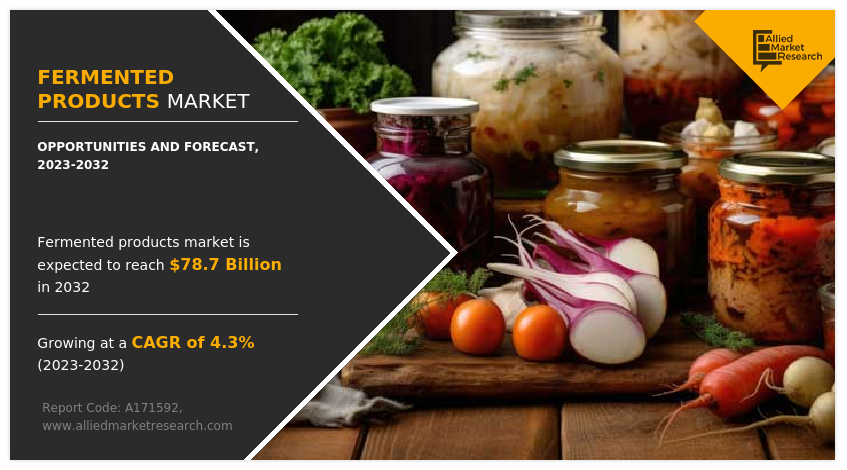
Market Dynamics
Customers' increasing curiosity towards health and fitness has resulted in tremendous growth in the fermented products market. Consumers nowadays utilize fermented products to strengthen their own immune systems as well as to stay healthy. As consumers become increasingly aware of the connection between their dietary intake and their overall health, they are looking for products that provide more than just vital vitamins and minerals. Fermented food are high in probiotics and are full of beneficial live microbes that improve intestinal health. Probiotics help maintain the gut microbes in equilibrium. A good intestinal microbiota is linked to a strong immune system, which increases the fermented products market demand. Fermented food products, such as certain plant-based alternatives, provide allergen-friendly options for consumers who have sensitivity towards dairy or gluten. Consumer well-being is being handled comprehensively, having an emphasis on their lifestyle choices, including food preparation, affecting their overall health. Fermented food are consistent with the principle of nourishing the body from the inside, thus increasing the demand for such types of food.
However, there are several challenges related to manufacturing and distribution of fermented products faced by the key players. These difficulties can vary depending on the kind of food that is fermented along with the precise manufacturing techniques used. Consistent product quality can be exceedingly difficult to maintain in large-scale production. As factors such as humidity, temperature, and duration of fermentation can affect the final product, stringent quality control processes are required. Fermentation is a biological and organic process; hence results are likely to differ from one batch to another batch. Maintaining a consistency in flavor, texture, and bacterial content between batches can be difficult. Large-scale manufacturing may pose additional challenges for monitoring in real time and variable control as compared to smaller batches.
Due to improvements in product development, consumer demand for fermented food products has grown and broadened. Food producers and manufacturers are continually seeking new ways to enhance their products, develop innovative fermented meals, and accommodate dynamic consumer preferences. Businesses are offering non-dairy alternatives by combining traditional dairy-based fermented drinks such as yogurt drinks with plant-based milk alternatives including almonds, soy, coconut, and oat milk. A few of the recently trending fermented food alternatives that offer convenient and healthy on-the-go options to consumers include chips rich in probiotics, pickled vegetables, and krauts. Businesses are incorporating fermentation into condiments, and dressings to enhance flavors and provide more probiotic benefits. As consumer tastes and eating habits evolve, manufacturers are searching for new chances to develop novel fermented food and beverages.
Segment Overview
The fermented products market is segmented on the basis of type, application, distribution channel, and region. By type, the market is divided into fermented food and fermented beverages. By application, the market is divided into residential and commercial. By distribution channel, the market is divided into offline channels and online channels. By region, the fermented products industry is divided into North America (the U.S., Canada, and Mexico), Europe (UK, Germany, France, Italy, Spain, Netherlands, Rest of Europe), Asia-Pacific (China, Japan, India, South Korea, Australia, and rest of Asia-Pacific), and LAMEA (Brazil, Argentina, Saudi Arabia, United Arab Emirates, South Africa, and the Rest of LAMEA).
By Type
By type, the market is categorized into fermented food and fermented beverages. The fermented food segment dominated the global market in 2022 and is likely to remain dominant during the fermented products market forecast period. One of the most popular fermented dairy products is yogurt. A typical side dish in Korea, kimchi is created from fermented vegetables. Both, Tempeh and Miso, two traditional fermented soy products from Indonesia and Japan respectively, are manufactured from whole soybeans. Cucumbers and other fruits and veggies that have been pickled in vinegar or a brine solution are called pickles. Probiotics, which are advantageous living bacteria that may colonize the gut, are abundant in fermented meals. A balanced gut microbiota is necessary for appropriate digestion, nutritional absorption, and a strong immune system. Probiotics aid in maintaining this equilibrium. Complex carbs and proteins are broken down into simpler forms during the fermentation process, which makes fermented meals gentler for the digestive system. The demand for fermented food has increased as a result of their health advantages, which positively impacts the fermented products market.
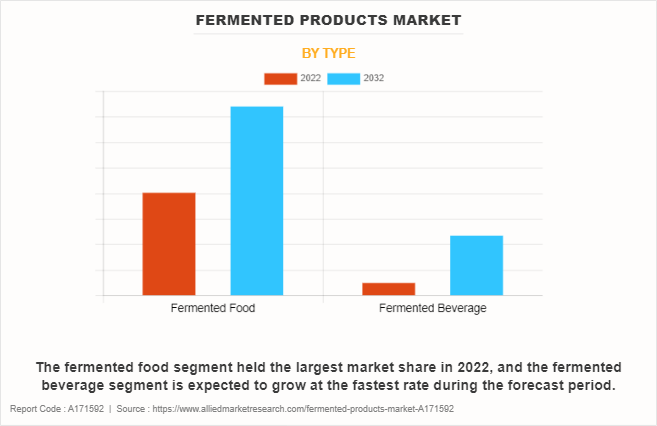
By Application
By application, the market is divided into residential and commercial. The residential segment dominated the global market in 2022 and is likely to remain dominant during the forecast period. Food fermentation has become increasingly popular among residential consumers. Fermented foods created at home, such as Korean kimchi, pickled vegetables, kombucha, fermented dairy products, and sourdough bread, are becoming more and more popular. Personalized and artisanal products can be produced at home by controlling their components, flavors, and fermentation times. Fermented ingredients are frequently experimented with by home cooks and food aficionados and added to a variety of dishes. Salads, sandwiches, sauces, stews, and other foods can all benefit nutritionally from the distinct aromas, textures, and benefits that fermented foods can bring. Residential consumption of fermented products is anticipated to increase substantially in the future due to expanding awareness among consumers, which also drives the fermented products market growth.
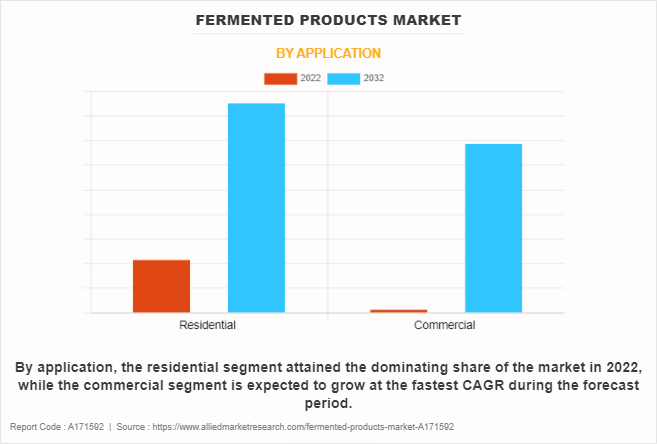
By Distribution Channel
By distribution channel, the market is divided into offline channels and online channels. The offline sales channel had the dominating fermented products market share in the year 2022 and is likely to remain dominant during the forecast period. The main offline retail locations for fermented foods are major grocery store chains and hypermarkets. These shops sell a wide range of items that have undergone fermentation, such as yogurt, kefir, sauerkraut, pickles, kimchi, and kombucha, among others. Organic, natural, as well as fermented food products frequently have their own sections at specialty supermarkets or health food stores. They offer probiotic-rich alternatives and distinctive fermented food variations to health-conscious consumers. For clients looking for high-quality selections, delis and gourmet shops frequently provide a variety of luxury and handcrafted fermented products, offering a distinctive shopping experience. Unique fermented foods from many cultural origins are available from local food sellers, especially ethnic grocery stores as well as specialty stores.
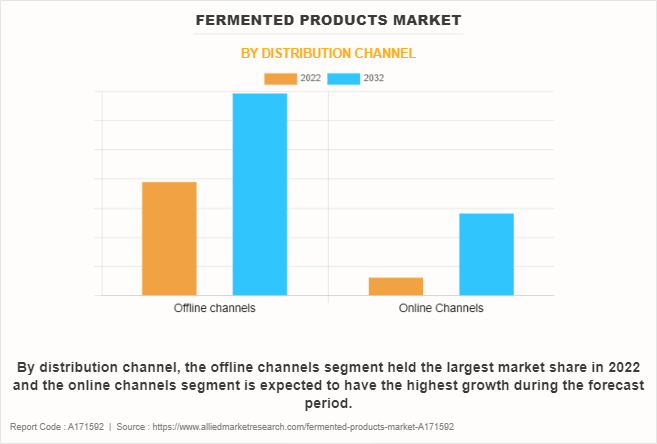
By Region
By region, the fermented products market size is divided into North America (the U.S., Canada, and Mexico), Europe (UK, Germany, France, Italy, Spain, Netherlands, Rest of Europe), Asia-Pacific (China, Japan, India, South Korea, Australia, and rest of Asia-Pacific), and LAMEA (Brazil, Argentina, Saudi Arabia, United Arab Emirates, South Africa, and the Rest of LAMEA). Consumers in North America have been looking for food and beverage items that could be beneficial to their health as they become more health conscious. Due to the high probiotic content as well as the benefits that they offer for digestion and gut health improvement, fermented food are favored by health-conscious consumers. Consumers in North America are willing to try out unfamiliar and out of the ordinary flavors as fermented food are available in such a wide range of flavors and textures.
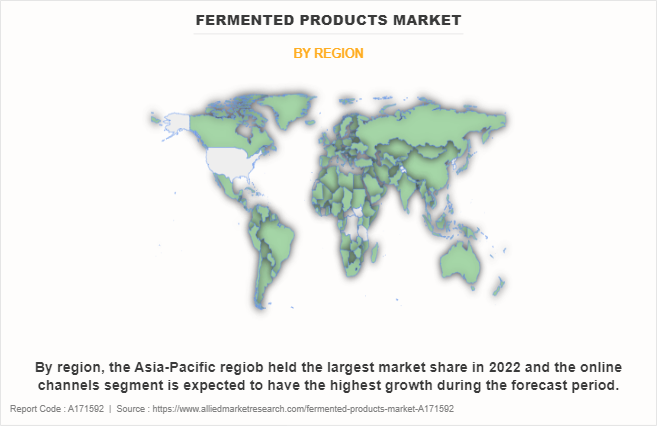
Competitive Landscape
Some of the major players analyzed in the fermented products market report are Again Drinks, Arla Food Amba, Chobani, Llc, Dana Dairy Group, Danone, General Mills, Gujarat Cooperative Milk Marketing Federation (Amul), Juhayna Food Industries, Lactalis Corporation, Marmum Dairy, Meiji Holdings Co., Ltd., National Dairy Development Board, Nestle S.A., Royal Friesland Campina, and Schreiber Food Inc.
Key Benefits for Stakeholders
- This report provides a quantitative analysis of the market segments, current trends, estimations, and dynamics of the fermented products market analysis from 2022 to 2032 to identify the prevailing fermented products market opportunities.
- The market research is offered along with information related to key drivers, restraints, and opportunities.
- Porter's five forces analysis highlights the potency of buyers and suppliers to enable stakeholders make profit-oriented business decisions and strengthen their supplier-buyer network.
- In-depth analysis of the fermented products market segmentation assists to determine the prevailing market opportunities.
- Major countries in each region are mapped according to their revenue contribution to the global market.
- Market player positioning facilitates benchmarking and provides a clear understanding of the present position of the market players.
- The report includes the analysis of the regional as well as global fermented products market trends, key players, market segments, application areas, and market growth strategies.
Fermented Products Market Report Highlights
| Aspects | Details |
| Market Size By 2032 | USD 78.7 billion |
| Growth Rate | CAGR of 4.3% |
| Forecast period | 2022 - 2032 |
| Report Pages | 300 |
| By Type |
|
| By Application |
|
| By Distribution Channel |
|
| By Region |
|
| Key Market Players | Juhayna Food Industries S.A.E., General Mills, Inc., Meiji Holdings Co., Ltd., Schreiber Foods Inc., Gujarat Cooperative Milk Marketing Federation Ltd., Arla Foods amba, DANA Dairy Group Ltd, Danone S.A., Royal FrieslandCampina N.V., Nestle S.A. |
Analyst Review
According to CXO’s top leading companies, the fermented products market is expected to witness a significant growth in the future. Fermented food are in demand owing to their distinctive flavors as well as their possible health advantages. To increase the nutritional value of fermented food, food manufacturers are adding extra functional ingredients including probiotics, vitamins, and antioxidants.
Fusion fermented food are gaining popularity as they combine methods and tastes from various culinary traditions. To appeal to customers with adventurous tastes, businesses regularly innovate and experiment with novel fermentation methods and flavor combinations. In order to appeal to consumers seeking thrilling culinary experiences, unusual and exotic flavors are rising in favor. However, throughout the fermentation process, food might go through sensory changes that some customers might not like. In addition, disparities in product quality or flavor between brands or homemade equivalents may affect consumers' opinions.
Home fermentation have become more common among individuals who cook at home. Consumers are experimenting with creating yogurt, kimchi, and other fermented food. The convenience and health advantages of fermented snacks, such as probiotic-rich chips, pickles, and krauts, have made them popular. fermented food is an increasingly popular natural and traditional technique of food preservation.
The global fermented products market size was valued at $52.5 billion in 2022, and is projected to reach $78.7 billion by 2032
The global Fermented Products market is projected to grow at a compound annual growth rate of 4.3% from 2023 to 2032 $78.7 billion by 2032
Some of the major players analyzed in the fermented products market report are Again Drinks, Arla Food Amba, Chobani, Llc, Dana Dairy Group, Danone, General Mills, Gujarat Cooperative Milk Marketing Federation (Amul), Juhayna Food Industries, Lactalis Corporation, Marmum Dairy, Meiji Holdings Co., Ltd., National Dairy Development Board, Nestle S.A., Royal Friesland Campina, and Schreiber Food Inc.
Based on region, Asia-Pacific held the highest market share in 2022, garnering nearly three-fifths of the global fermented products market revenue, and is likely to dominate the market during the forecast period.
Rise in health and wellness awareness among consumers, Growing interest in international cuisines, High popularity of plant-based fermented food
Loading Table Of Content...
Loading Research Methodology...



